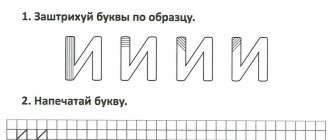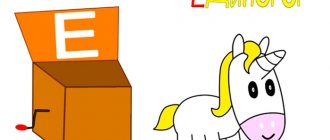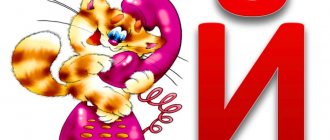Thunderstorm of schoolchildren
0
The letter “yat” was a kind of mark that distinguished “primordial” and Slavic words among Russian words. The object of heated debate for “Westerners” and “Slavophiles” on the issue of reform of Russian spelling. A real torment for high school students. However, resourceful young minds, to help themselves, even composed a poem composed only of words starting with “yat”: B?ly, b?ld, b?b?s Killed the hungry one. He fucked with the l?su, R?dkoy and the hr?nom drank And for the bitterness he gave about the b?d. The first to speak out in favor of o was the writer and translator Dmitry Yazykov: “The letter ?... is like an ancient stone lying out of place, over which everyone stumbles and does not take it aside just because it is ancient and was once needed for a building.” . But already in Soviet times, Alexander Solzhenitsyn, known for his conservatism, advocated for the return of “yatya” along with “er” to Russian grammar.
The most expensive letter
0
Erb is a “silent” letter that did not denote any sound and performed the functions of a “hard sign”, which was traditionally written at the end of words after hard consonants until the spelling reform of 1918. However, at the same time, “er” took up more than 8% of the time and paper during printing and cost Russia more than 400,000 rubles annually. A real embezzler letter, no less!
MAGAZINE Preschooler.RF
Summary of a lesson on speech development Topic: “Sound and letter E”in the senior group of MBDOU kindergarten No. 42 “Mammoth .
Educator: Vasilyeva Sakhayana Petrovna
Program content:
- contribute to the development of sound-letter analysis
- promote the development of phonemic hearing
- introduce the vowel sound E and its symbol - red square
- learn to determine the place of a sound in a word and designate it on a diagram using a symbol
- introduce the letter E using a sample
- learn to write the printed letter E using a sample
- consolidate the ability to correlate sounds and letters, write the vowels A, O, U, Y
- learn to understand a learning task and complete it independently
- develop the skill of self-control and self-esteem.
I'm playing the game "Finish the Sentence"
- Complete the sentence with the correct word
Ice cream on a stick is called... (popsicle)
This house has five... (floors)
The plane landed at ... (airfield)
- Name the first sound in the words popsicle, floor (E)
— Is there an E sound in the word airfield? (Yes)
- Where is he located? (In the middle)
- Draw a red square in the diagrams - where this sound is in the name of the object.
Then I give the task on the sheet:
— The letter E is written in the left corner, and in the right is its comic image.
— I’m reading a poem by I. Blyumkin
With electricity, friends, You need to be careful, Because, like a snake, It can bite.
Assignment for children
- write the letter E first by dots, and then by yourself.
I conduct physical education at the request of the children.
I’m playing the game “Write it correctly .
I read I.A.’s poem to the children. Guseva
What sounds - Like songs, There are no obstacles on the way. Vocalists as artists
Name them in words.
Tasks and questions for children:
—What sounds are talked about in the poem? (About vowels)
— Identify the first vowel sound in the names of the drawn objects and write the corresponding letter in the square.
— What is the vowel sound in the word bull? (s)
— Write the letter Y in the square.
Note. I remind the children that in the Russian language there are no words that begin with the sound Y.
I'm playing the game "Who's More" .
Assignment for children:
- Name words with given sounds (A, O, U, Y, E)
A: watermelon, bus, pear, bunny, hat, orange, stork, aquarium, asters.
A: donkey, umbrella, coat, wasps, knife, kidneys, daughter, autumn, lake.
U: iron, snail, frog, student, bow, beetle, fly, duck, ear, lesson.
S: smoke, lynx, cheese, skis, fish, mouse, soap, pumpkin.
E: screen, floor, excavator, echo, express, electricity, airfield.
At the end of the lesson we analyze the work.
| Next > |
Lesson summary “Sound and letter E”
Irina Solodenko
Lesson summary “Sound and letter E”
Topic: “ Sound and letter E ”
Corrective and developmental tasks.
1. Teach the child to identify a word from a series that differs from the rest in syllable structure.
2. Learn to distinguish between animate and inanimate objects, learn to ask appropriate questions: who is this? What is this?
3. Teach the child to clearly pronounce the sound [E] .
4. Exercise the child in pronouncing words with a complex syllabic structure.
5. Learn to read sentences, observing narrative and interrogative intonation.
6. Teach the child to reflect interrogative and narrative intonation in writing using a period and a question mark.
Task 1. An adult pronounces a series of words, and the child listens attentively and names a word that differs from the others in its syllabic structure:
poppy - bak - so - banana; catfish - com - turkey - house; lemon - carriage - cat - bud; poppy - cancer - broom - tank.
Task 2. Introducing the sound [E] .
Guess the riddle, name the first sound in the answer :
Lives without a body
Speaks without tongue.
Nobody sees him
And everyone hears. (Echo)
An adult shows in front of a mirror and explains to the child the articulation of the sound [E] :
- lips in a smile;
- teeth are close together;
— the wide tip of the tongue touches the lower teeth, the back of the tongue is raised;
- the neck “works”
.
symbol [E] : the girl reproachfully says to the kitten: “EEE.”
(see color insert)
.
Characteristics of the sound [E] : the sound [E] is a vowel , it can be sung (the tongue, lips and teeth do not interfere with the free passage of air)
. Designation: red circle.
Task 3. Phonetic exercise.
What do fishermen say when a fish gets off the hook? “Uh. X!"
Task 4. Didactic exercise “Clap your hands if you hear the sound [E] ”
:
uh, ah, uh, y, oh, uh. ; eh, ah, uh, eh. ; Emma, Anna, Edik, echo, Olya.
Task 5. Repeat after the adult a series of syllables:
pte-kte-bde-where; kte-bde-gde-pte.
Task 6. Find an extra word in a series (by the presence or absence of the sound [E] )
:
bus, echo, orange, watermelon; this is an echo, Edik, a mustache.
Task 7. Remember the names of people starting with the sound [E] (Ella, Edik, Eduard, Eleanor, Emma)
.
Task 8. From a number of drawn objects, choose those whose names contain the sound [E] .
Task 9. Speak to the child, syllable by syllable, words that have a complex syllabic structure, explaining to him the meaning of these words. Divide words into syllables. Find the longest and shortest word. If possible, make a sentence with each word:
tightrope walker, squadron, electric welder, electric locomotive, electric iron, guide, electrician, crew, electrical appliance, eucalyptus, elevator.
Task 10. Explain to the child that all animate objects answer the question: who is this, and inanimate objects answer the question: what is this? Learn to ask questions to animate and inanimate objects.
Continue the series:
Who is this? This is a girl, a cat, a dog.
What is this? This is a car, a table, a jacket.
Didactic game “Odd Four”
(based on the animate or inanimate nature of objects)
:
car, plane, table, grandfather; crow, nightingale, chair, cow.
Task 11. Introducing letter E.
The letter E opened its mouth:
Either he yawns or he sings.
O. Hoffman
What else does the letter E ?
Letter E from fingers : the thumb and index fingers of the right hand form a semicircle, and the index finger of the left hand forms the “tongue”
letter
E. Letter games .
Task 12. Independent sound-syllable analysis of the word Edik : creating a diagram of circles; laying out letters in a cut alphabet , reading, copying.
Reading sentences in compliance with interrogative and narrative intonation. Writing sentences under dictation with the help of an adult, reflecting interrogative and narrative intonation in writing (using a period and a question mark)
.
Who is this? It's a cat. Who is this? This is Edik. Who is this? This is a fly.
Message to the Slavs
0
The usual set of letters of the Russian alphabet is actually nothing more than a “message to the Slavs.” Each of the letters of the Cyrillic alphabet has its own name, and if you read these names in alphabetical order, you get: “Az buki vede. The verb is good. Live well, earth, and, like people, think about our peace. Rtsy’s word is firm - uk f’at dick. Tsy, worm, shta ra yus yati.” One of the translations of this text is: “I know the letters: writing is a property. Work hard, earthlings, as reasonable people should - comprehend the universe! Carry the word with conviction: knowledge is the gift of God! Dare, delve deeply in order to comprehend the light of existence!”
0
How a letter became a word
0
In the Cyrillic alphabet, the letter “f” bore the intricate name “fert”. The phrase “stand fert” appeared, arms akimbo, and then a new noun “fert”, and even a diminutive “fertik”. In general, in the Slavic alphabet there were two letters to indicate the sound “f” - “fert” and “fita”, but this was a real confusion! The word “Philip” was then written with “f”, and “Fedor”, “arithmetic” with “fita”. Go figure it out! (And to understand, remember: in the Greek alphabet the letter “f” stands for the sound “ph”, and “phyta” or “theta” - “th”). The noun "fert" over time became disapproving, half-abusive. From A. Chekhov: “Here a little ferret comes to us with a violin, squealing,” from Pushkin: “There’s a young fert standing by the wall like a magazine picture.”






